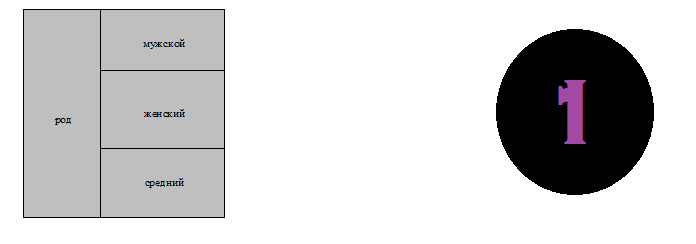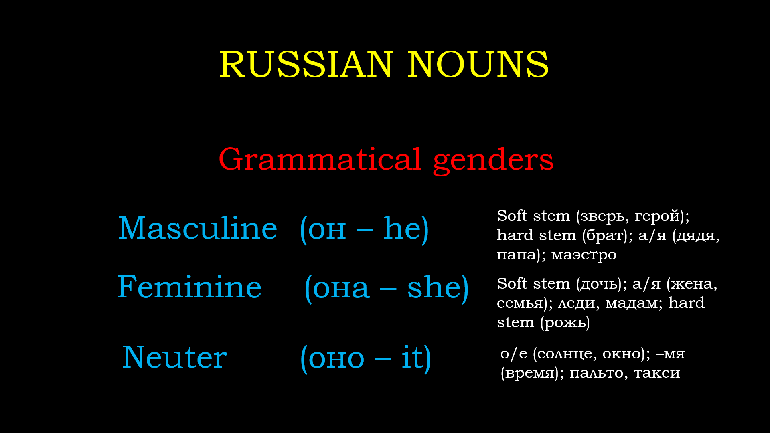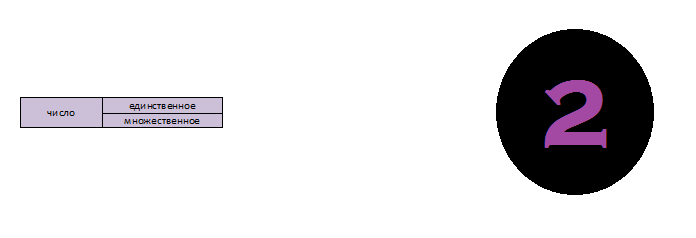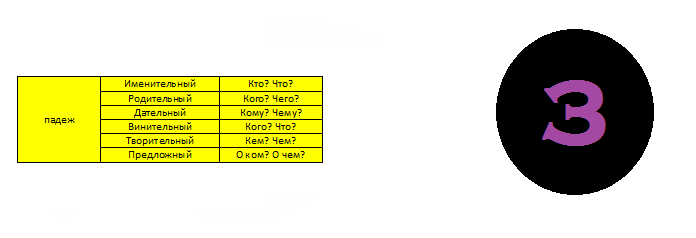Russian nouns
Comparing Russian and English Nouns
Russian nouns and English nouns have several notable differences. Firstly, Russian nouns are categorized into three grammatical genders (masculine, feminine, and neuter), each of which impacts the forms of associated adjectives and verbs. In contrast, English nouns don't have grammatical gender. Additionally, Russian nouns decline to reflect case (nominative, genitive, dative, accusative, instrumental, and prepositional), affecting their role in a sentence, while English nouns generally have a fixed form, with case distinctions primarily limited to pronouns. English nouns rely more heavily on word order for sentence structure, whereas Russian nouns' endings and cases play a more pivotal role in conveying meaning and relationships within a sentence.
Nouns in Russian language
In this article, we'll delve into the essential aspects of Russian nouns to help you grasp the key concepts. First, we'll explore gender in Russian nouns, which affects word forms and agreement. Next, we'll examine how Russian nouns indicate singular and plural forms, a crucial element of the language. Lastly, we'll decode grammatical cases, the structures that define a noun's role in sentences. These topics are fundamental to understanding and effectively using Russian nouns.
Nouns answer the questions ‘
What is it?’ and ‘Who is it?’
If you want to learn Russian through words, you can find
Russian audio sentences for each grammatical case here –
Russian dictionary
.

Russian grammatical genders

Masculine
Masculine nouns, one of the three genders, encompass a wide array of words typically associated with male entities or inanimate objects. They are often marked by their distinctive endings, such as consonants, and they follow specific patterns of declension to indicate their function in sentences. The grammatical gender, masculine, has different forms within the six grammatical cases, including the nominative, genitive, dative, accusative, instrumental, and prepositional cases. Masculine nouns in Russian exhibit various endings and changes depending on their role, which can be a source of complexity for you as a learner. Understanding the gender and case of masculine nouns is essential for accurate and nuanced expression in the Russian language.
In the Russian language, masculine nouns are classified based on their "stem" type. The stem is the part of the word to which grammatical changes are applied. Different stems can affect how the noun changes in various grammatical cases, including the nominative, genitive, dative, accusative, instrumental, and prepositional cases. These stem types are crucial for understanding noun declension, a key aspect of grammatical gender in Russian.
Hard stem
"Hard stem" nouns are those that exhibit consonant endings in their nominative singular forms, specifically ending in consonants like -к, -г, -х, -ч, -ж, -ш, -ц, and other consonants such as -б, -п, -д, -т, -м, -н, -л, and -ф, among others. These consonants determine the "hard stem" categorization and impact the way the nouns change when used in different grammatical cases.
"Hard stem" nouns are often have the same form in both the nominative and accusative cases. For example, take the noun "город" (city). In the nominative case, you would say "Этот город красив" (This city is beautiful), in accusative case - Я посетил этот город. (I visited this city.) Another example is the noun "дом" (house), which in the accusative case becomes Я видел этот дом. (I saw this house.) and in nominative - Этот дом большой. (This house is big.)
– брат , лоб, гол
Soft stem
Nouns with a soft stem usually end in one of the soft consonants, such as -ь, -й, -е, or -и. Unlike their "hard stem" counterparts, soft-stem masculine nouns follow different patterns when changing forms in the grammatical cases.
– герой, гость
Russian nouns with endings -а or -я
In Russian, masculine nouns with endings in -а or -я belong to a specific declension pattern. These nouns are categorized as having a "soft stem."
Indeclinable nouns
These nouns do not change their forms across different grammatical cases. They remain the same in the nominative, accusative, genitive, and other cases. Masculine indeclinable nouns are typically foreign words or loanwords, and they are treated as exceptions to the usual Russian noun declension patterns.
For example, the word "кафе" (cafe) is a masculine indeclinable noun. In the nominative case, it's "это кафе" (this is a cafe), and in the accusative case, it's also "это кафе" (this is a cafe). There is no change in form.
– маэстро
Nouns with suffixes
– домишко, домина
Feminine
Feminine nouns are associated with female entities and various inanimate objects, but gender assignment is largely grammatical rather than reflecting real-world gender.
Russian nouns with endings -а or -я
Many common feminine nouns end in -а or -я, including "девушка" (girl), "книга" (book), "мама" (mom), "страна" (country), and "работа" (work).
Hard stem
In Russian grammar, the term "hard stem" is more commonly associated with masculine nouns. The example below is not a proper hard stem, but rather an exception or a specific pattern associated with certain words.
(жь, шь) – рожь
Soft stem
This variation in consonant softness is characteristic of certain feminine nouns, especially those ending in -ь, and is not a universal pattern for all feminine nouns in the Russian language.
– дочь
Indeclinable nouns
They are typically loanwords or words borrowed from other languages, particularly from non-Slavic languages.
– леди, мадам
Neuter
Russian nouns with endings -о or -е
n Russian, neuter nouns typically end in -о or -е, and these endings are a key indicator of their gender.
Russian nouns with endings мя
Nouns with the ending "мя" are relatively rare in the Russian language, but they do exist.
– время
Indeclinable nouns
These nouns maintain the same form in the nominative, genitive, dative, accusative, instrumental, and prepositional cases. Like feminine indeclinable nouns, they are usually loanwords or words borrowed from other languages.
– пальто, такси
Navigating Singular and Plural Forms in Russian Nouns

One of the key challenges for you as a learner of the Russian language is understanding and correctly using the singular and plural forms of nouns. In Russian, nouns change form to indicate whether you're talking about one thing or multiple things. This feature, known as grammatical number, plays a significant role in the language. To form the plural of a noun in Russian, various rules come into play. Nouns often undergo changes in their endings, typically by adding specific suffixes. The exact changes depend on the gender and the ending of the noun in the singular form. For instance, masculine nouns ending in a consonant may add "-ы" or "-и" to the end, while feminine nouns ending in "-а" change it to "-ы" or "-и." Neuter nouns, which often end in "-о" or "-е," may add "-а" or "-я" to become plural. Navigating this complexity is essential for constructing accurate sentences in Russian and ensuring subject-verb and adjective-noun agreement.
Furthermore, understanding the nuances of singular and plural forms is crucial when discussing quantities and expressing concepts like "one," "some," and "many." Russian adjectives, pronouns, and verbs need to agree with the grammatical number of the nouns they modify or are associated with. While the rules for forming plurals are systematic, there are exceptions and irregularities that learners must be aware of. These nuances emphasize the need for practicing and internalizing the patterns and exceptions to navigate singular and plural forms effectively in Russian nouns.
- Masculine Nouns with "Soft Sign" (ь): Some masculine nouns ending in a soft sign (ь) form their plural by replacing the soft sign with "и," such as "друг" (friend) becoming "друзья" (friends).
- Nouns with "ь" in the Singular: Nouns ending in "ь" in the singular form may have unpredictable plurals. For example, "путь" (path) becomes "пути" (paths), not "пути."
- Nouns Ending in -е or -o: Neuter nouns ending in "-е" may change to "-я" in the plural. For instance, "окно" (window) becomes "окна" (windows), "поле" (field) becomes "поля" (fields), "место" (place) changes to "места" (places).
- Nouns with Irregular Plural Forms: Certain nouns, such as "человек" (person) and "год" (year), have irregular plural forms that don't follow the typical patterns, like "люди" (people) and "годы" (years).
- Nouns with Unpredictable Vowel Changes: Some nouns exhibit unpredictable vowel changes in the plural. For instance, "мать" (mother) becomes "матери" (mothers).
- Plurals of Borrowed Words: Loanwords and borrowed nouns often maintain their original language's plural forms. For example, "какао" (cocoa) remains "какао" in the plural, following the English pattern.
Decoding Grammatical Cases in Russian Nouns

Understanding grammatical cases in Russian nouns is a fundamental aspect of the language, and it often poses a significant challenge for learners. These cases, denoted by "падеж" (padezh) in Russian, indicate a noun's role in a sentence. Think of them as different "hats" that each noun wears, helping to determine where it is and what it's doing. Let's explore these cases in more detail and delve into their relationship with verbs.
Nominative Case (Именительный падеж)
This is like the noun's "default" hat, used for the subject of a sentence—the one doing the action. It's the most straightforward case, usually following the verb. For instance, "Кот (cat) спит (is sleeping) в комнате (in the room) потому, что (because) он (he) устал (is tired)." Here, "кот" is the subject (nominative), "спит" is the verb, "в комнате" gives us the place, and "потому, что" connects it to the reason.
Genitive Case (Родительный падеж)
This "hat" shows possession or belonging, often used with prepositions like "у" (of). It can help indicate the noun's relationship to the verb. For example, "Добра ему не хватает" translates to "He lacks kindness." In this phrase, "добра" in the genitive case indicates the absence of kindness. "Шляпа кота (the cat's hat) на полке (on the shelf) снаружи (outside) дома (of the house)." In this case, "кота" is in the genitive form, showing the hat's owner, "на полке" specifies the location, and "снаружи дома" reveals the place and relationship with the house.
Dative Case (Дательный падеж)
This is the hat for showing who benefits, receives, or, in some cases, experiences something, often used with verbs of giving or communicating. "Коту не повезло" can be translated as "The cat wasn't lucky." In this instance, "коту" in the dative case conveys the cat's misfortune or experience. "Я дал подарок коту (I gave a gift to the cat) в день рождения (on the birthday)." Here, "коту" is in the dative case, highlighting the recipient, while "в день рождения" adds the occasion.
Accusative Case (Винительный падеж)
This hat is for the direct object, the thing that the action is happening to. "Кот видит мышь (The cat sees the mouse) в саду (in the garden) для прогулок (for walks)." The noun "мышь" is in the accusative case, showing that it's the direct object of the action, while the prepositional phrases provide additional information.
Instrumental Case (Творительный падеж)
This hat shows how something is done or with what tool, often indicating means or manner. "Я рисую мягким карандашом (I'm drawing with a soft pencil), потому что мои наброски выглядят лучше, чем с жёстким карандашом (because my sketches look better than with a hard pencil)." "Карандашом" is in the instrumental case, revealing the tool, and the prepositional phrases indicate the purpose.This choice of a soft pencil is deliberate and results in improved sketches.
Prepositional Case (Предложный падеж)
This is the hat for talking about location, being "in" or "on" something, or the place where something happens. "Кот сидит на столе (The cat is sitting on the table) в гостиной (in the living room) потому, что он устал (because he is tired)." "На столе" is in the prepositional case, showing the location, while "в гостиной" provides more context, and "потому, что он устал" explains the purpose, which is to rest because he is tired.